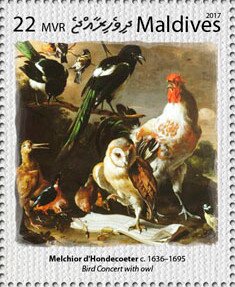Stamp: "Bird Concert with Owl", by Melchior d'Hondecoeter (Maldives 2017)
"Bird Concert with Owl", by Melchior d'Hondecoeter (Maldives 2017)
21 June (Maldives ) within release Paintings of Owls goes into circulation Stamp "Bird Concert with Owl", by Melchior d'Hondecoeter face value 22 Maldivian rufiyaa
| Stamp "Bird Concert with Owl", by Melchior d'Hondecoeter in catalogues | |
|---|---|
| Michel: | Mi: MV 7130 |
Stamp is square format.
Issue acknowledged by the Maldive postal authorities, but only distributed by the Maldive philatelic agent for collecting purposes.Also in the issue Paintings of Owls:
- Stamp - "Snowy Owl" (detail, 1831), by John James Audubon face value 22;
- Stamp - "Bird Concert with Owl", by Melchior d'Hondecoeter face value 22;
- Mini Sheet - Paintings of Owls face value 4*22;
- Stamp - "Mottled Owl" (detail), by John James Audubon face value 22;
- Souvenir Sheet - Paintings of Owls face value 70;
- Stamp - "An Owl's Lunch", by George William Sartorius face value 22;
- Stamp - "The Little Owl" (1506)), by Albrecht Dürer face value 70;
Stamp "Bird Concert with Owl", by Melchior d'Hondecoeter it reflects the thematic directions:
Animals are multicellular, eukaryotic organisms of the kingdom Animalia (also called Metazoa). All animals are motile, meaning they can move spontaneously and independently, at some point in their lives. Their body plan eventually becomes fixed as they develop, although some undergo a process of metamorphosis later on in their lives. All animals are heterotrophs: they must ingest other organisms or their products for sustenance.
Birds (Aves), a subgroup of Reptiles, are the last living examples of Dinosaurs. They are a group of endothermic vertebrates, characterised by feathers, toothless beaked jaws, the laying of hard-shelled eggs, a high metabolic rate, a four-chambered heart, and a strong yet lightweight skeleton. Birds live worldwide and range in size from the 5 cm (2 in) bee hummingbird to the 2.75 m (9 ft) ostrich. They rank as the class of tetrapods with the most living species, at approximately ten thousand, with more than half of these being passerines, sometimes known as perching birds. Birds are the closest living relatives of crocodilians.
Owls are birds from the order Strigiformes, which includes over 200 species of mostly solitary and nocturnal birds of prey typified by an upright stance, a large, broad head, binocular vision, binaural hearing, sharp talons, and feathers adapted for silent flight. Exceptions include the diurnal northern hawk-owl and the gregarious burrowing owl.
Painting is the practice of applying paint, pigment, color or other medium to a solid surface (support base). The medium is commonly applied to the base with a brush, but other implements, such as knives, sponges, and airbrushes, can be used. Painting is a mode of creative expression, and the forms are numerous. Drawing, gesture (as in gestural painting), composition, narration (as in narrative art), or abstraction (as in abstract art), among other aesthetic modes, may serve to manifest the expressive and conceptual intention of the practitioner. Paintings can be naturalistic and representational (as in a still life or landscape painting), photographic, abstract, narrative, symbolistic (as in Symbolist art), emotive (as in Expressionism), or political in nature (as in Artivism). A portion of the history of painting in both Eastern and Western art is dominated by spiritual motifs and ideas. Examples of this kind of painting range from artwork depicting mythological figures on pottery, to Biblical scenes rendered on the interior walls and ceiling of the Sistine Chapel, to scenes from the life of Buddha or other images of Eastern religious origin. In art, the term painting describes both the act and the result of the action. The support for paintings includes such surfaces as walls, paper, canvas, wood, glass, lacquer, clay, leaf, copper and concrete, and the painting may incorporate multiple other materials including sand, clay, paper, plaster, gold leaf, as well as objects. The term painting is also used outside of art as a common trade among craftsmen and builders.




